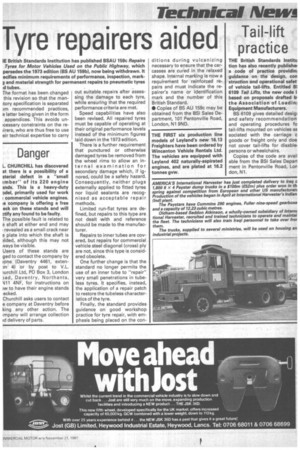IE British Standards Institution has published BSAU 159c Repairs Tyres
Page 11

If you've noticed an error in this article please click here to report it so we can fix it.
for Motor Vehicles Used on the Public Highway, which persedes the 1973 edition (BS AU 159b), now being withdrawn. It ecifies minimum requirements of performance, inspection, markand material strength for permanent repairs to pneumatic tyres d tubes.
The format has been changed this revision so that the man'tory specification is separated )m recommended practices, a latter being given in the form appendices. This avoids unicessa ry constraints on the relirers, who are thus free to use eir technical expertise to carry out suitable repairs after assessing the damage to each tyre, while ensuring that the required performance criteria are met.
Speed capabilities have also been revised. All repaired tyres must be capable of operating at their original performance levels instead of the minimum figures laid down in the 1973 edition.
There is a further requirement that punctured or otherwise damaged tyres be removed from the wheel rims to allow an internal examination for secondary damage which, if ignored, could be a safety hazard. Consequently, neither plugs externally applied to fitted tyres nor liquid sealants are recognised as acceptable repair methods.
Limited run-flat tyres are defined, but repairs to this type are not dealt with and reference should be made to the manufacturer.
Repairs to inner tubes are covered, but repairs for commercial vehicle steel diagonal (cross) ply are not, since this type is considered obsolete.
One further change is that the standard no longer permits the use of an inner tube to "repair" very small penetrations in tubeless tyres. It specifies, instead, the application of a repair patch to restore the tubeless characteristics of the tyre.
Finally, the standard provides• guidance on good workshop practice for tyre repair, with emphasis being placed on the con ditions during vulcanizing necessary to ensure that the carcasses are cured in the relaxed shape. Internal marking is now a requirement for reinforced repairs and must indicate the repairer's name or identification mark and the number of this British Standard.
• Copies of BS AU 159c may be obtained from the BSI Sales Department, 101 Pentonville Road, London, Ni 9ND.


















































